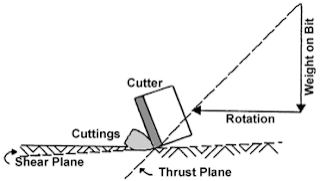Brief Introduction Of PDC Drill Bit

Brief introduction of PDC drill bit
Polycrystalline diamond compact (PDC) drill bits are made with synthetic diamond cutters in either steel or matrix body material.PDC drill bits revolutionized the drilling industry with a wide application range and high rate of penetration (ROP) potential.
PDC Bits are designed and manufactured as:
§ Matrix-body bit
§ Steel-body bits
MATRIX-BODY
Matrix is a very hard and brittle composite material comprising tungsten carbide grains metallurgically bonded with a softer, tougher, metallic binder. It’s more erosion-resistant than steel. They are preferred in high solid-content drilling mud.
Advantages-
1. Matrix is desirable as a bit material over steel because its hardness is resistant to abrasion and erosion.
2. It is capable of withstanding relatively high compressive loads.
3. For diamond-impregnated bits, only matrix-body construction can be used.
Disadvantages-
1. Compared with steel, it has low resistance to impact loading.
2. The lower impact toughness of the matrix limits some matrix-bit features, such as blade height.
STEEL-BODY
Steel is metallurgically opposite of matrix. Steel bodied bits are generally preferred for soft and non-abrasive formations and large hole size. To reduce the bit body erosion, bits are hard-faced with a coating material that is more erosion resistant and sometimes receives an anti-balling treatment for very sticky rock formations such as shales.
Advantages-
1. Steel is ductile, tough, and capable of withstanding greater impact loads.
2. It is capable of withstanding high impact loads, but is relatively soft and, without protective features, would quickly fail by abrasion and erosion.
3. Because of steel material capabilities, complex bit profiles and hydraulic designs are possible and relatively easy to construct on a multi-axis, computer-numerically-controlled milling machine.
Disadvantages-
1. Steel body is less erosion-resistant than the matrix and, consequently, more susceptible to wear by abrasive fluids.
PDC bits drill primarily by shearing. A vertical penetrating force from the applied weight on bit and horizontal force from the rotary table is transmitted into the cutters. The resultant force defines a plane of thrust for the cutter. Cuttings are then sheared off at an initial angle relative to the plane of thrust, which is dependent on rock strength.

The wide application range for PDC bits requires unique PDC cutter technology to get the most drilling performance in each application. The Optimal cutter portfolio will maximize performance in any drilling challenge.
Contact us at www.zzbetter.com for more information about our PDC cutter for the PDC drill bit.





















